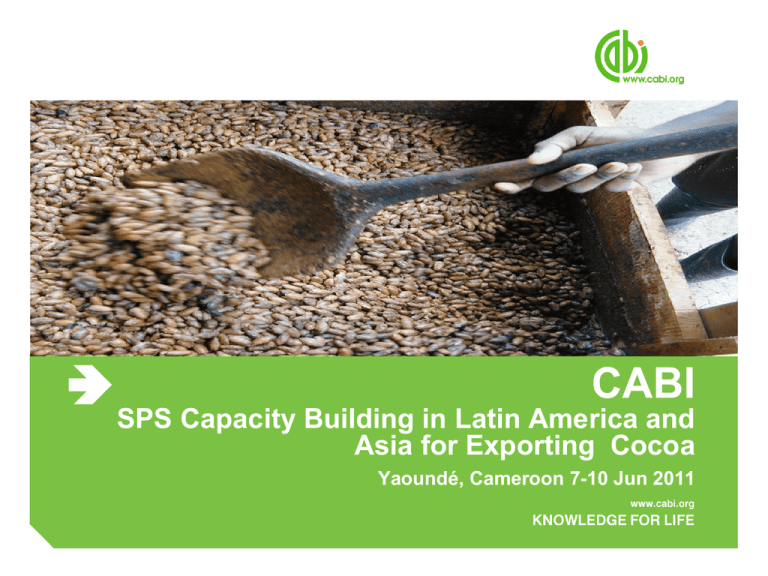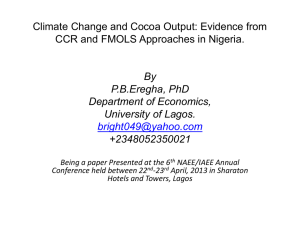SPS Capacity Building in Latin America and Asia for Exporting Cocoa
advertisement

CABI SPS Capacity Building in Latin America and Asia for Exporting Cocoa Yaoundé, Cameroon 7-10 Jun 2011 Agenda ● About CABI as PEA for Latin America and Asia phase ● Project Background ● Aims, objectives and approach adopted ● A bit about the countries ● SPS activities in Caribbean and Asia ● Gap analysis (ICCO survey completed by T&T - CCIB) ● Proposed solutions and activities ● Quality Management System for Cocoa Value Chain What is CABI? CABI is a not for profit organization providing scientific expertise, knowledge and information. KNOWLEDGE FOR LIFE At a glance ● CABI specialises in agriculture and the environment ● Activities include: scientific publishing, research, consultancy, training and communication ● 100 years old, established in 1910 by UN treaty ● Owned by 45 member countries ● Over 350 staff based in 13 countries CABI has three areas of operation Publishing Scientific Projects & Consultancy Microbial Services Our scientific work focuses on three key areas: Commodities Knowledge for Development Invasive Species Our people CABI staff locations: ● ● ● ● ● ● ● ● ● ● ● ● ● UK Centres (Wallingford, Ascot, Egham) South Asia Regional Centre (Pakistan) Africa Regional Centre (Kenya) Switzerland Centre South East Asia Regional Centre (Malaysia) Caribbean & Latin America Regional Centre (Trinidad) Brazil Office China Office India Office Costa Rica Office Netherlands Office USA Office Australia Office Project Background • Consumer concerns on food safety and threat of contaminants to human health • Pesticides, fungicides, herbicides – Toxic • Ochratoxin A (OTA) & mycotoxins – Damages DNA (mutagen) • FFA (Free/trans Fatty Acid) – Diabetes • PAHs (Polycyclic Aromatic Hydrocarbons) – Carcinogens • Heavy metals Cadmium (Cd) – Highly toxic and Carcinogenic Lead (Pb) – Carcinogen can cause miscarriages and infertility in males Mercury (Hg) – Damages nervous system Cr(VI) (hexavalent chromium) – Toxin and Carcinogen Project Aims and objectives Overall objective: To maintain market access for cocoa beans from Latin America and Asia through capacity building in SPS Specific objectives: ● To raise farmer awareness on SPS standards of international cocoa market ● To enhance cocoa farmers capacity to apply GAP from pre- to post-harvest procedures to meet SPS stds ● To enhance institutional capacity in-country to monitor and enforce adherence to SPS stds in cocoa ICCO member Countries and Fine Flavour Rating: Brazil, Dominican Republic-40%P, Ecuador-75%P, Venezuela-95%P, Papua New Guinea-90%P, Trinidad and Tobago-100%E, Malaysia, Indonesia-1%P Approach: Consultations with stakeholders to define SPS activity and needs in Latin America & Asia Trinidad and Tobago Indonesia ● Mapping of Cd soils ● In 2009, established ● Training in Cd testing ● Soil amelioration or selective ● ● ● ● sequestration (anthuriums) Cd low/free fertilizers, biofertilizers/rhizobacteria Use Cd beans for butterfat Farm certification/traceability ISO Certified lab for OTA and Cd SNI 01-2323-2008 on Cocoa Powder and Beans with WTO T&T gap analysis (ICCO survey sent Oct 2010 - completed by CCIB) ● Need to improve regulation of agrochemicals 1. Find alternative method to reduce contamination caused by diesel fuel driers 2. Implement a HACCP system to improve SPS controls including training of personnel 3. Implement a total quality management system (QMS) throughout the cocoa value chain 1. Alternatives to Diesel driers • Problem: Polycyclic Aromatic Hydrocarbon (PAH) – byproducts of burning fuels (fossil or biomass) • Solution: Solar drying – UTT model for fermentaries ~ US$100,000 Diesel Dryer Simple Solar Dryer 2. Implement HACCP system Hazard Analysis and Critical Control Point -HACCP: ● Internationally accepted system used to ensure safe procedures and products in food production. ● Set of 7 proactive and preventative standards for identification and control of safety hazards which must be implemented for certification. 1. Hazard Analysis 4. Monitoring Procedures 2. Critical Control Points 5. Corrective Actions 3. Critical Limits 6. Verification 7. RECORD KEEPING 2. Implement HACCP system Cont’d VERIFCATION & CERTIFICATION by CARIRI ● Developing testing & certification capacity at CARIRI. Have equipment and HR for testing – need training with cocoa pesticides and herbicides residues (MRLs) (since 2007 capacity for organophosphate and organochloride testing; Gel Permeation Chromatography (GPC), 2 GCs and 1 GC-MS (gold std for FFA and some pesticides) Ochratoxin A (ELISA not done in T&T yet- insufficient demand) Heavy Metals (Cadmium) - RoHS compliance (Restriction of 4 Hazardous Substances) - test by GC-MS Free Fatty Acids (FFAs) – test by GC-MS Polycyclic Aromatic Hydrocarbons (17 PAHs) – by GPC 2. Implement HACCP system Cont’d VERIFCATION & CERTIFICATION by CARIRI Timely testing of samples and Delivery of results Issue COA- Certifies compliance to Residue Levels in sample Cost per sample ~US$1,200 (to be paid by importer) Pesticide testing – US$500 Heavy metal – US$50 FFA – US$100 PAH – US$500 Idle capacity – testing services to other ICCO member countries (DR, Venezuela and Ecuador) risk mitigation 2. Implement HACCP system Cont’d Who needs to be trained – Website and workshops Outputs: Manuals & Videos produced Cocoa farmers in Quality Management System (QMS) for pre- and post-harvest to adhere to HACCP standards Fermentary operators in QMS for fermenting and drying beans to HACCP stds Shippers and Cargo consolidators to handle cocoa beans as food to HACCP stds. Possible registration with CCIB requirement. 3. Quality Management System (QMS) for Cocoa Value Chain in T&T QMS is systematic approach to business and production processes with an emphasis on customer and quality outcome ● Customer – Cocoa importing countries (meet regulations) ● Quality – HACCP Certification ● Business – Cocoa production 3. Quality Management System (QMS) for Cocoa Value Chain in T&T The Cocoa Value Chain in T&T GAP/modifications in Production (use of biofertilizers, right pesticides and herbicides/shade) – from land prep to pod harvest Systems approach to Harvesting and processing pods Systems approach to Fermenting and drying Good Warehouse Practices (GWP) for dry bean storage (HACCP) GWP for shipping of beans (HACCP) 3. Quality Management System (QMS) for Cocoa Value Chain in T&T The Cocoa Value Chain in T&T GAP in Pre-harvest (use of fertilizers, pesticides and herbicides) Meet RoHS (Cd, Hg, Pb, Cr (Vi)) standards Approved list issued by CCIB Increase bean production on farm from 200 to 600 kg/acre. Appropriate irrigation Appropriate drainage to reduce Cd deposition in fields 3. QMS for Cocoa Value Chain in T&T The Cocoa Value Chain in T&T Systems approach to Post-Harvest processes for quality Farm registry for traceability Harvest only healthy pods at maturity Grading and cleaning of beans Fermenting by time requirement: 5 or 7 days before fermentation Trained labour gangs to help farmers harvest and get beans to fermentary same day. Labour and age of farmers are major constraints 3. QMS for Cocoa Value Chain in T&T The Cocoa Value Chain in T&T Systems approach to Fermenting and drying Some mechanization for handling beans Flow process from receiving beans, fermenting thru to moving beans to dryers to HACCP stds Mechanize movement of beans thru fermentary operations 3. QMS for Cocoa Value Chain in T&T The Cocoa Value Chain in T&T Systems approach to Fermenting and drying Standardize fermenting conditions Standardize Drying conditions in appropriate dryers Value added - Make blends to suit customer Fermenting by time requirement: 5 or 7 days 3. Quality Management System (QMS) for Cocoa Value Chain in T&T Good Warehouse Practices Temperature controlled storage 20 or 40 shipping foot containers fitted with AC unit to reduce infestation and mold growth Powered by low cost (US$500) solar or wind generators Shipped by certified cargo handlers Result is a QMS backed by a certified lab that can be adapted or modified by all producing countries to meet contaminant and quality requirements





